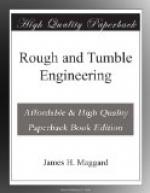It will be a good plan for you to take a look at the nozzle on blower now and then, to see that it does not become limed up and to see that it is not turned to the side so that it directs the steam to the side of stack. Should it do this, you will be using the steam and getting but little, if any, benefit. It will also be well for you to remember that you can create too much draught as well as too little; too much draught will consume your fuel and produce but little steam.
A GOOD FIREMAN.
What constitutes a good fireman? You no doubt have heard this expression: “Where there is so much smoke, there must be some fire.” Well, that is true, but a good fireman don’t make much smoke. We are speaking of firing with coal, now. If I can see the smoke ten miles from a threshing engine, I can tell what kind of a fireman is running the engine; and if there is a continuous cloud of black smoke being thrown out of the smokestack, I make up my mind that the engineer is having all he can do to keep the steam up, and also conclude that there will not be much coal left by the time he gets through with the job; while on the other hand, should I see at regular intervals a cloud of smoke going up, and lasting for a few moments, and for the next few moments see nothing, then I conclude that the engineer of that engine knows his business, and that he is not working hard; he has plenty of steam all the time, and has coal left when he is through. So let us go and see what makes this difference and learn a valuable lesson. We will first go to the engine that is making such a smoke, and we will find that the engineer has a big coal shovel just small enough to allow it to enter the fire door. You will see the engineer throw in about two, or perhaps three shovels of coal and as a matter of course, we will see a volume of black smoke issuing from the stack; the engineer stands leaning on his shovel watching the steam gauge, and he finds that the steam don’t run up very fast, and about the time the coal gets hot enough to consume the smoke, we will see him drop his shovel, pick up a poker, throw open the fire door and commence a vigorous punching and digging at the fire. This starts the black smoke again, and about this time we will see him down on his knees with his poker, punching at the underside of the grate bars, about the time he is through with this operation the smoke is coming out less dense, and he thinks it time to throw in more coal, and he does it. Now this is kept up all day, and you must not read this and say it is overdrawn, for it is not, and you can see it every day, and the engineer that fires in this way, works hard, burns a great amount of coal, and is afraid all the time that the steam will run down on him.
Before leaving him let us take a look at his firebox, and we will see that it is full of coal, at least up to the level of the door. We will also see quite a pile of ashes under the ash pan. You can better understand the disadvantage of this way of firing after we visit the next man. I think a good way to know how to do a thing, is to know also, how not to do it.




